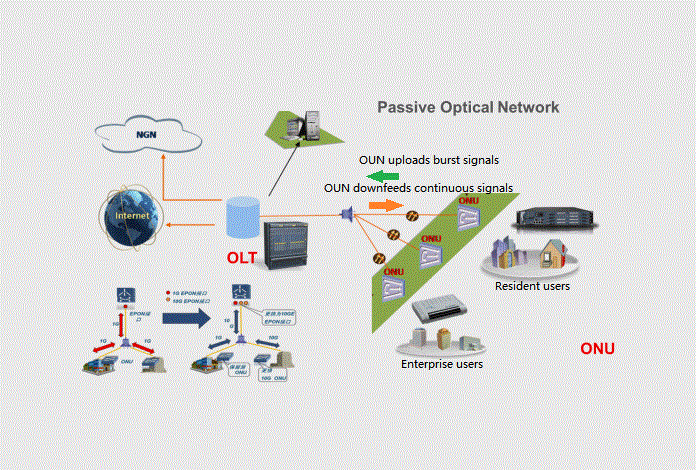In the PON system, the OLT is connected with multiple onus (optical network units) through POS (passive optical splitter). As the core of PON, OLT optical module will directly affect the operation of the whole PON system.
In the PON, the OLT downlink data is transmitted in the broadcast continuous mode, and the ONU uplink data is composed of burst mode data packets sent by multiple user terminals in the manner of time division multiple access.
The receiving part of the OLT operates in burst mode. The OLT optical receiver must be able to adapt to different optical powers of different ONU signals. The receiver needs to have a large dynamic range and set a threshold to make decisions at the fastest speed; The OLT optical receiver must be able to quickly recover the correct clock of each burst signal transmitted from different nodes.

Factors affecting OLT performance:
• ONU preamble length (timing): different equipment manufacturers have different timing requirements
• Length of guard time between burst data packets of multiple onus: different manufacturers have different timing requirements
• Two onus double packet test different attenuation power differences: it is necessary to verify the maximum allowable power drop in the actual use environment
• OLT receives SD signal jitter:
• OLT receiving reset position and width: different manufacturers have different requirements for reset position and width
• whether dual reset control (net noise) is supported: combo PON requires dual reset
• response speed of different batches of TIA chips of OLT module to burst signals (performance degradation):
• Location of clock extraction from receiving diagram: different manufacturers have different requirements for reset location and width
• Poor soldering at one end of differential signal leads to deterioration of one signal and good quality of the other
Semight Burst Mode Bert rBT1250 is specially designed for burst error test and analysis of 1.25g EPON, GPON, 2.5G xGpon, combo PON, 10G EPON and 10G XGSPON applications. rBT1250 provides three independent channel data pattern generators and Bit Error detection, supports continuous mode or burst mode bit error analysis, and has the capability of time division or wavelength division bit error analysis for two bursts at the same time. The code type timing is flexible and adjustable. According to the device test requirements, the corresponding test channels are provided with synchronous low-speed control channels such as laser enable and reset signals. In addition, the built-in clock recovery of rBT1250 can automatically range, and there is no problem with long fiber testing. Thus greatly simplifying the test setup, connection, floor space and test cost.


 2022.07.17
2022.07.17 
